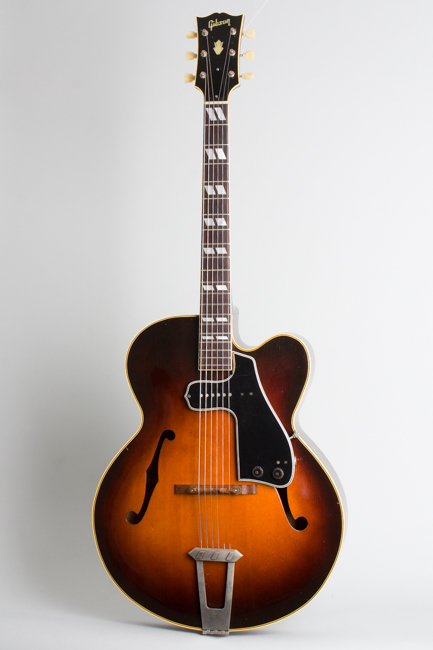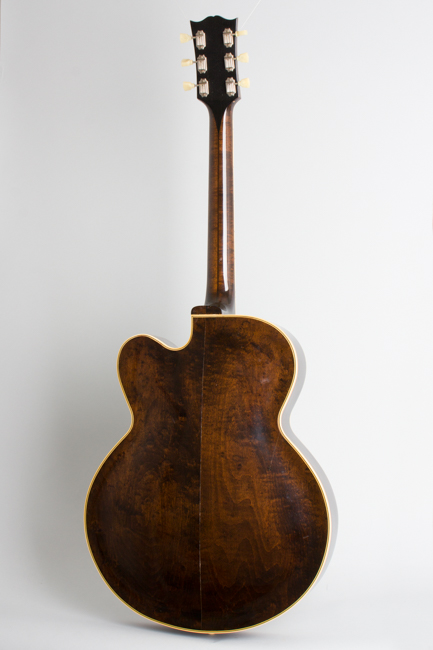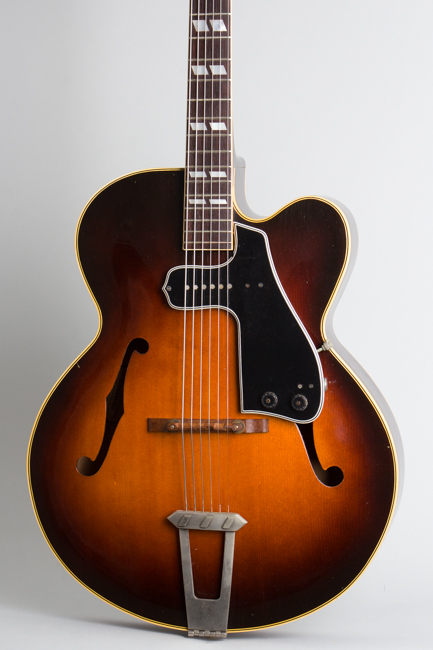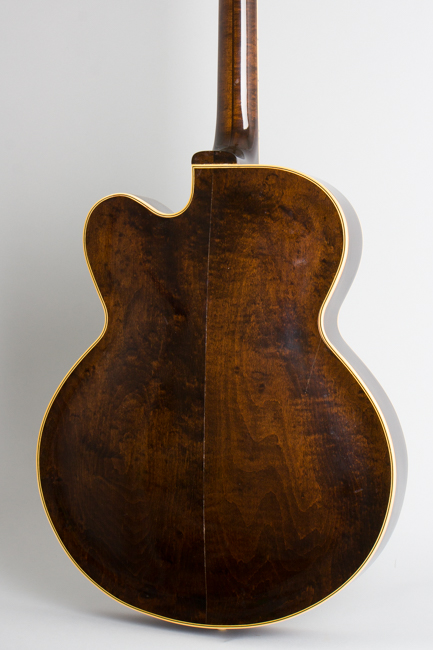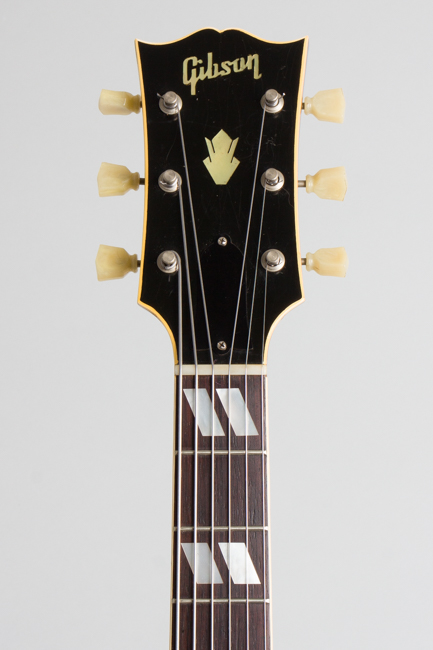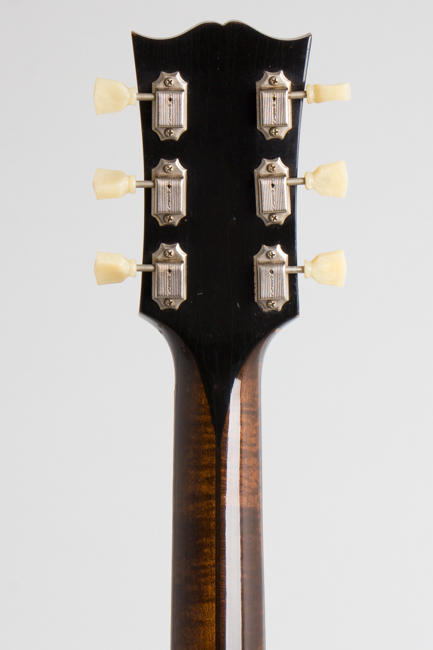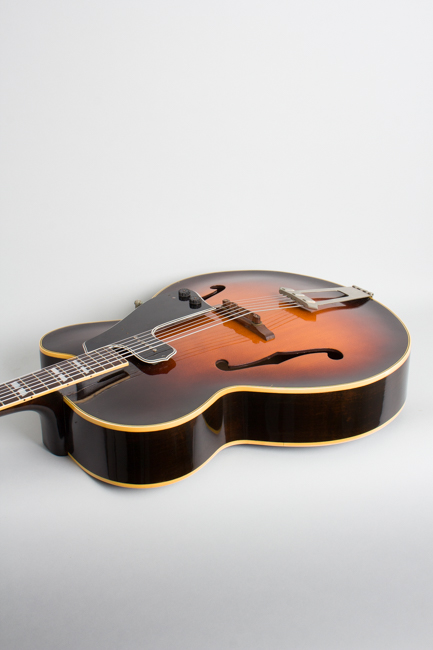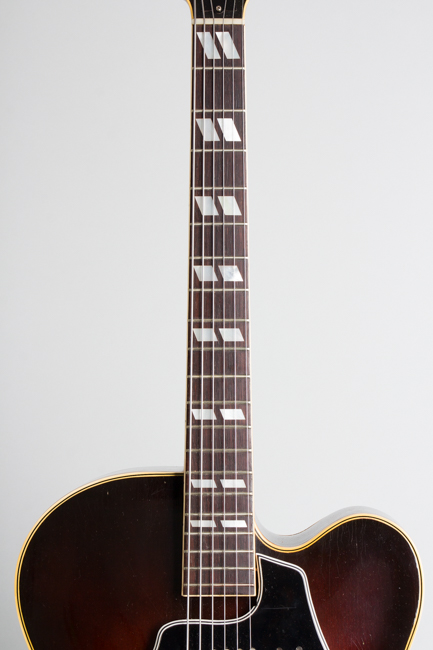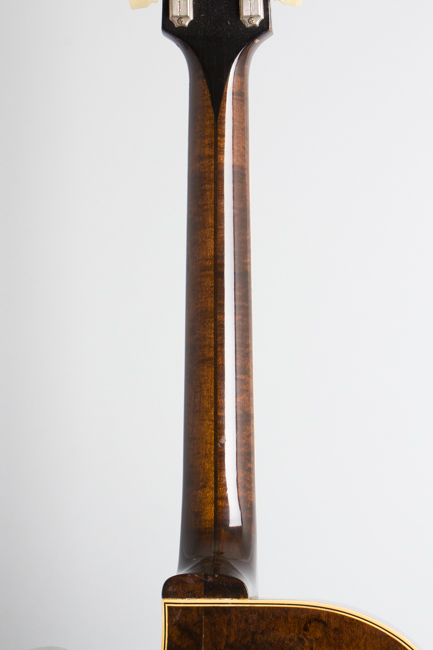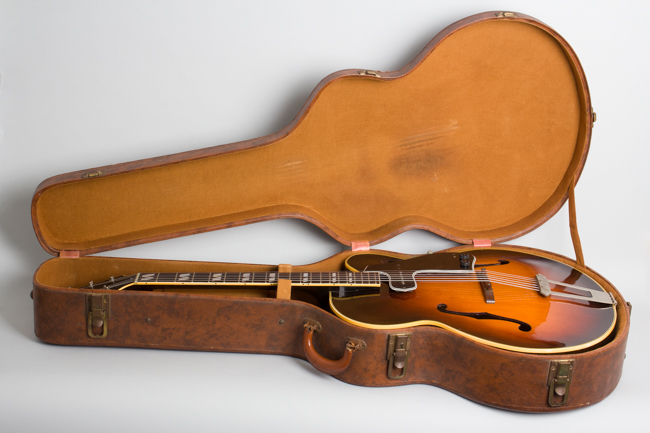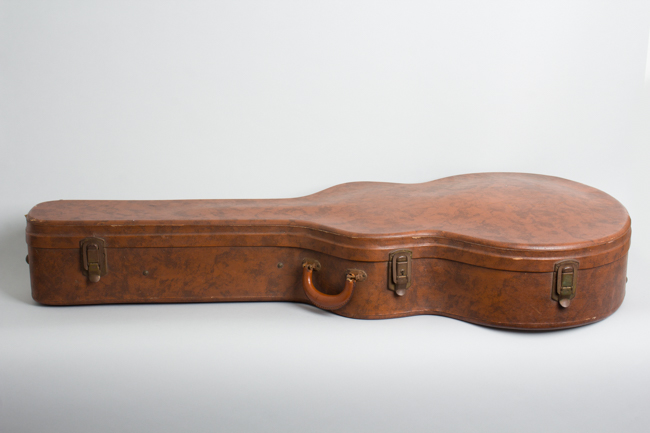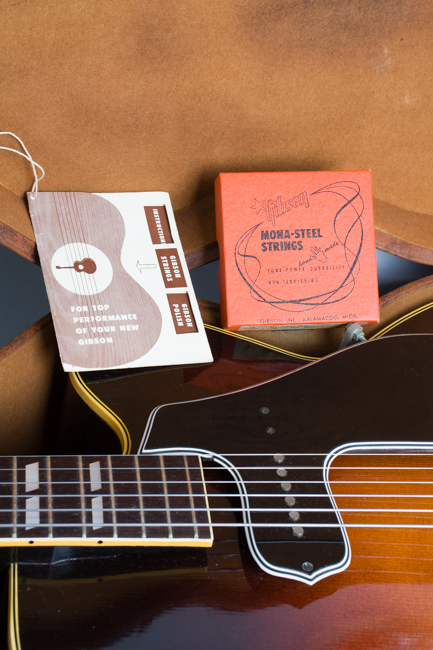Gibson L-7CE Arch Top Acoustic Guitar (1950)
This item has been sold.
Item # 9724
Prices subject to change without notice.
Gibson L-7CE Model Arch Top Acoustic Guitar (1950), made in Kalamazoo, Michigan, serial # A-5447, sunburst top, dark back and sides finish, maple back and sides, spruce top; maple neck with rosewood fingerboard, original brown hard shell case.
This dawn-of-the 1950's L-7CE is a lovely solid wood cutaway archtop guitar fitted with an interesting Gibson period innovation: the short-lived self-contained Fingerrest/pickup assembly. This was Gibson's answer to the period DeArmond "guitar mike" pickup, which was extremely popular at the time with players desiring to amplify their acoustic archtops. Obviously Gibson wanted a piece of the action, and one of new president Ted McCarty's first jobs after arriving at the company was to come up with a solution, and the patent application was filed in his name in November 1948.
The Gibson unit goes DeArmond one better by actually integrating the pickup, controls and pickguard into one unit, which can be removed to convert the guitar back into an acoustic. The pickup actually sounds very good, but in practice never seriously challenged the DeArmond pickup hegemony, and Gibson found much greater success building dedicated electric guitars. The fingerrest unit has since become known as the "McCarty Pickup" and was officially available for any Gibson archtop, but only offered as a stock appointment on the L-7C.
This is a factory L-7CE ("E" for electric) as confirmed by the original hang tag still in the case. The other features on this L-7C are the same as the standard acoustic model and typical for the period. The neck is maple with a center laminate, the top is carved spruce and the rim and back are maple. The neck and headstock are single bound, with triple binding on the top and back. The pearl inlay is a parallelogram pattern on the rosewood fingerboard with Gibson's traditional crown on the headstock.
The bridge, tailpiece and tuners are standard period fittings; the Kluson Deluxe pegs with tulip buttons are the very earliest style with the shaft completely enclosed by the housing. The white Gibson "artist" label inside the body indicates a shipping date of June/July 1950, one of 71 shipped with the pickup assembly that year. With or without electronics the L-7C was Gibson's perennial working man's carved top guitar, a pro grade instrument at a reasonable price and one of Kalamazoo's best values over the years. This is a great-playing and sounding solid wood archtop acoustic/electric guitar, well on par with many more expensive Gibsons either plugged in or unplugged. It includes original brown HSC in extremely nice condition, with the original hangtag and an orange period Gibson string box.
Overall length is 42 1/2 in. (108 cm.), 17 in. (43.2 cm.) wide at lower bout, and 3 1/4 in. (8.3 cm.) in depth, measured at side of rim. Scale length is 25 1/2 in. (648 mm.). Width of nut is 1 3/4 in. (44 mm.).
This L-7 remains in very fine original condition overall, especially for being over 72 years old. The finish is all original and very clean with hardly any real wear, just some checking and a few scattered small dings and scratches. All hardware is original except possible the rosewood bridge, which is the correct Gibson piece but a split-base style usually seen later in the 1950s.
The back center seam has been visibly resealed with some minor finish chipping but no overfinish; that is the only notable repair. The original frets and the rosewood fingerboard show virtually no wear and playability is excellent. The pickup unit works as designed and the guitar also makes a very fine acoustic instrument with or without it fitted. This is a truly lovely piece, an exceptionally nicely preserved period survivor complete in the original brown HSC. Overall Excellent + Condition.
This dawn-of-the 1950's L-7CE is a lovely solid wood cutaway archtop guitar fitted with an interesting Gibson period innovation: the short-lived self-contained Fingerrest/pickup assembly. This was Gibson's answer to the period DeArmond "guitar mike" pickup, which was extremely popular at the time with players desiring to amplify their acoustic archtops. Obviously Gibson wanted a piece of the action, and one of new president Ted McCarty's first jobs after arriving at the company was to come up with a solution, and the patent application was filed in his name in November 1948.
The Gibson unit goes DeArmond one better by actually integrating the pickup, controls and pickguard into one unit, which can be removed to convert the guitar back into an acoustic. The pickup actually sounds very good, but in practice never seriously challenged the DeArmond pickup hegemony, and Gibson found much greater success building dedicated electric guitars. The fingerrest unit has since become known as the "McCarty Pickup" and was officially available for any Gibson archtop, but only offered as a stock appointment on the L-7C.
This is a factory L-7CE ("E" for electric) as confirmed by the original hang tag still in the case. The other features on this L-7C are the same as the standard acoustic model and typical for the period. The neck is maple with a center laminate, the top is carved spruce and the rim and back are maple. The neck and headstock are single bound, with triple binding on the top and back. The pearl inlay is a parallelogram pattern on the rosewood fingerboard with Gibson's traditional crown on the headstock.
The bridge, tailpiece and tuners are standard period fittings; the Kluson Deluxe pegs with tulip buttons are the very earliest style with the shaft completely enclosed by the housing. The white Gibson "artist" label inside the body indicates a shipping date of June/July 1950, one of 71 shipped with the pickup assembly that year. With or without electronics the L-7C was Gibson's perennial working man's carved top guitar, a pro grade instrument at a reasonable price and one of Kalamazoo's best values over the years. This is a great-playing and sounding solid wood archtop acoustic/electric guitar, well on par with many more expensive Gibsons either plugged in or unplugged. It includes original brown HSC in extremely nice condition, with the original hangtag and an orange period Gibson string box.
Overall length is 42 1/2 in. (108 cm.), 17 in. (43.2 cm.) wide at lower bout, and 3 1/4 in. (8.3 cm.) in depth, measured at side of rim. Scale length is 25 1/2 in. (648 mm.). Width of nut is 1 3/4 in. (44 mm.).
This L-7 remains in very fine original condition overall, especially for being over 72 years old. The finish is all original and very clean with hardly any real wear, just some checking and a few scattered small dings and scratches. All hardware is original except possible the rosewood bridge, which is the correct Gibson piece but a split-base style usually seen later in the 1950s.
The back center seam has been visibly resealed with some minor finish chipping but no overfinish; that is the only notable repair. The original frets and the rosewood fingerboard show virtually no wear and playability is excellent. The pickup unit works as designed and the guitar also makes a very fine acoustic instrument with or without it fitted. This is a truly lovely piece, an exceptionally nicely preserved period survivor complete in the original brown HSC. Overall Excellent + Condition.
